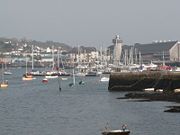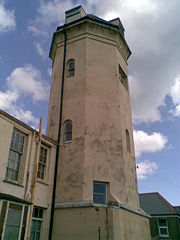Falmouth, Cornwall
| Falmouth | |
| Cornish: Aberfal | |
 Falmouth shown within Cornwall |
|
| Population | 21,635 (2001 Census |
|---|---|
| OS grid reference | |
| Parish | Falmouth |
| District | Carrick |
| Shire county | Cornwall |
| Region | South West |
| Constituent country | England |
| Sovereign state | United Kingdom |
| Post town | FALMOUTH |
| Postcode district | TR11 |
| Dialling code | 01326 |
| Police | Devon and Cornwall |
| Fire | Cornwall |
| Ambulance | South Western |
| European Parliament | South West England |
| UK Parliament | Falmouth and Camborne |
| List of places: UK • England • Cornwall | |
Falmouth (Cornish: Aberfal) is a town, civil parish and port on the River Fal on the south coast of Cornwall, England, UK. It has a total resident population of 21,635.[1]
The name Falmouth comes from the river Fal; the origin of the river name is unknown.
Falmouth is the terminus of the A39, which passes in succession close to the neighbouring town of Penryn.
Contents |
Falmouth harbour
Falmouth is famous for its harbour. Together with Carrick Roads, it forms the third deepest natural harbour in the world, and the deepest in Western Europe. It is also famous for being the start or finish point of various round-the-world record-breaking voyages, such as those of Sir Francis Chichester and Dame Ellen MacArthur.
Falmouth Docks Police provide policing for the docks.
History
See also: Miss Susan Gay's Falmouth chronology
Originally called Peny-cwm-cuic, which later became 'Pennycomequick',[2] it was the site where Henry VIII built Pendennis Castle to defend Carrick Roads, in 1540. The main town was at Penryn. Sir John Killigrew created the town of Falmouth shortly after 1613.[3]
In the late 16th century, under threat from the Spanish Armada, the defences at Pendennis were strengthened by the building of angled ramparts.
During the Civil War, Pendennis Castle was the second to last fort to surrender to the Parliamentary Army.
After the Civil War, Sir Peter Killigrew received Royal patronage when he gave land for the building of the Church of King Charles the Martyr, dedicated to Charles I, "the Martyr"[4].
The news of Britain's victory (and Admiral Nelson's death) at Trafalgar was landed here from the schooner Pickle and taken to London by stagecoach.
The Falmouth Packet Service operated out of Falmouth for over 160 years between 1689 and 1851. Its purpose was to carry mail to and from Britain's growing empire. In 1839 Falmouth was the scene of the gold dust robbery when £4,600 worth of gold dust from Brazil was stolen on arrival at the port[5].
19th & 20th Centuries

The Falmouth Docks were developed from 1858.[6]
The Cornwall Railway reached Falmouth on 24 August 1863. The railway brought new prosperity to Falmouth, as it made it easy for tourists to reach the town. It also allowed the swift transport of the goods recently disembarked from the ships in the port. The town now has three railway stations. Falmouth Docks railway station is the original terminus and is close to Pendennis Castle and Gyllyngvase beach. Falmouth Town railway station was opened on 7 December 1970 and is convenient for the National Maritime Museum Cornwall, the waterfront, and town centre. Penmere railway station opened on 1 July 1925 towards the north of Falmouth and within easy walking distance of the top of The Moor. All three stations are served by regular trains from Truro on the Maritime Line. Penmere Station was renovated in the late 1990s, using the original sign and materials, and is now a fine example of an early 20th century railway station.
During World War II, 31 people were killed in Falmouth by German bombing. It was also the launching point for the famous Commando raid on St Nazaire. An anti-submarine net was laid from Pendennis to St Mawes, to prevent enemies entering the harbour.
Economy, industry and tourism

While Falmouth's maritime activity has much declined from its heyday, the docks are still a major contributor to the town's economy. It is one of the largest ports in Cornwall. Falmouth is still a cargo port and the bunkering of vessels and the transfer of cargoes also keep the port's facilities busy. The port is also becoming popular with cruise ship operators with sixty-four cruise ship calls to Falmouth due in 2007.
Further up the sheltered reaches of the Fal there are several ships laid up, awaiting sailing orders and/or new owners/charterers.
With its fine Georgian town houses converted into guest houses and small hotels, often overlooking one of the beaches, Falmouth has proven a popular holiday destination and it is now primarily a tourist resort. The five main beaches starting next to Pendennis Castle and moving along the coast towards the Helford river are Castle, Tunnel, Gyllyngvase, Swanpool and Maenporth beaches. The National Maritime Museum Cornwall opened in February 2003. The building was designed by architect, M.J. Long.[7]
University College Falmouth
University College Falmouth has two campuses in the Falmouth area; the original town site, Woodlane, and the other in the Combined Universities in Cornwall campus at Tremough, Penryn. The University offers undergraduate and postgraduate courses chiefly in the fields of Art, Design and Media. University College Falmouth is known worldwide for its award winning Journalism course, which boasts such graduates as Angus Walker and Fergus Walsh and the Graphic Design course which wins many coveted awards annually, such as the D&AD award. Another notable course is MA Fine Art: Contemporary Practice, lead by internationally acclaimed artist Daro Montag. Falmouth Marine School, formerly Falmouth College specialises in Marine Engineering, Marine Environmental Science and Marine Leisure Sport. The campus is part of Cornwall College which is registered through Plymouth University. The college acts as a fist and second college for sixth form students and for undergratuate student, ranging from NVQ's, ND's to Foundation Degrees (formally Higher National Diplomas).
Culture

The Lady of the Lamp, Florence Nightingale, visited Falmouth and stayed at the town's Greenbank Hotel. Her name in the register can be viewed at the hotel today.
Falmouth has many literary connections. The town was the birthplace of Toad, Mole and Rat. Kenneth Grahame's classic Wind in the Willows began as a series of letters sent to his son. The first two were written at the Greenbank Hotel whilst Grahame was a guest in May 1907. Reproductions of the letters are currently on display in the hotel. Poldark author Winston Graham knew the town well and set his novel The Forgotten Story (1945) in Falmouth.
The town has been the setting for several films and television programmes. British film star Will Hay was a familiar face in Falmouth in 1935 whilst filming his comedy Windbag the Sailor. The movie had many scenes of the docks area. The docks area was featured in some scenes with John Mills for the 1948 film Scott of the Antarctic. Robert Newton, Bobby Driscoll and other cast members of the 1950 Walt Disney movie Treasure Island, (some scenes were filmed along the river Fal), were visitors to the town. Stars from the BBC TV serial The Onedin Line stayed in the town during filming in the late 1970s.
The town has a football team in the South Western League, Falmouth Town F.C., who play at Bickland Park in the south-west of the town, and also Falmouth RFC, a rugby union club who play at a site at the top of The Moor.
Falmouth has the first and last "Polytechnic": Royal Cornwall Polytechnic Society.
Recreation

With its proximity to sheltered and unsheltered waters, Falmouth has long been a popular boating and water sports location. Solo yachtsman Robert Manry crossed the Atlantic from Falmouth, Massachusetts to Falmouth, Cornwall from June-August 1965 in the thirteen and a half foot Tinkerbelle - this was the smallest boat to make the crossing at the time. The town was the location for the 1998 Tall Ships' Race in which approximately ninety Tall Ships set sail for Lisbon, Portugal. It also saw total coverage of the total eclipse of the sun at 11:11am on 11 August 1999 where the eclipse lasted just over two minutes — the longest duration in the UK.
Notable former and present residents
- W. J. Burley, author, was born here.
- Sebastian Coe, former athlete and politician was the Member of Parliament for the area in the 1990s.
- Joseph Conrad, 9 months in 1882 Short story, Youth
- Thomas Corker, Chief agent for the Royal African company in York Island, Sherbro
- Fox family of Falmouth
- Dawn French, comedian
- Lenny Henry, comedian
- Steve McFadden, actor — plays Phil Mitchell in popular British soap opera EastEnders
- Paul Martin (TV presenter) presenter of BBC antiques programme Flog It!
- Philip Melvill, philanthropist, whose name was used for a Falmouth road.
- David Mudd, TV presenter and politician. He was the Member of Parliament for the area in the 1970/80s.
- Tim Rice, lyricist
- Hugh Scully, TV presenter
- Howard Spring, author
- John Sterling (1806-1844), author
- Richard Thomas, Civil Engineer — in 1815, he produced a survey of the navigation of the River Severn.
- Sam Toy, industrialist and chairman of Ford of Britain, was educated at Falmouth Grammar School.
- Miles Tredinnick, playwright
- Henry Scott Tuke, artist
- Luke Vibert, musician. AKA Wagon Christ, Plug, Amen Andrews, Kerrier District.
Fictional residents
- Richard Bolitho — a fictional Royal Navy officer who was the main character in a series of books set in the late 18th and early 19th centuries. The books were written by Douglas Reeman (using the pseudonym Alexander Kent).
- Ned, Perry and Madge in the Winston Graham book The Forgotten Story published in 1945.
Gallery
Twinning
 Douarnenez, Brittany
Douarnenez, Brittany
See also
- List of topics related to Cornwall
- All Saints' Church, Falmouth
- St. Michael and All Angels Church, Penwerris
References
- ↑ "Key Statistics for urban areas in England and Wales" (PDF). National Office of Statistics (2004). Retrieved on 2008-01-13.
- ↑ "Falmouth Town". GenUKi. Retrieved on 2008-07-14.
- ↑ "Falmouth 1837". Old Towns of England. Retrieved on 2007-05-25.
- ↑ Guide to the Parish Church (No date, after 1997)
- ↑ The Times Saturday, Jun 29, 1839; pg. 6: The Gold-Dust Robbery
- ↑ "Falmouth Docks". Falmouth Packet Archives 1688-1850. Retrieved on 2008-07-14.
- ↑ "Falmouth International Maritime Initiative". Long/Kentish Practice. Retrieved on 2008-07-14.
External links
- Official Tourist Information for Falmouth
- Falmouth Town Council
- National Maritime Museum Cornwall
- Photos of Falmouth from Views of Cornwall
- Falmouth Harbour Commissioners
- University College Falmouth
- Cornwall Record Office Online Catalogue for Falmouth
- GENUKI article on Falmouth
|
|||||||||||||||||||||||||||||||
|
||||||||||